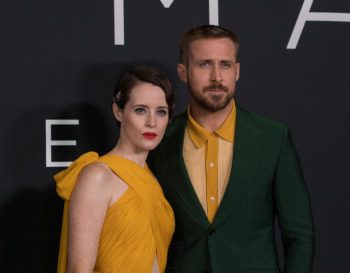The new and popular film, First Man, is taking off in cinemas, exploring the trials and tribulations Neil Armstrong faced to be the first man on the moon.

The first thing to point out about First Man is that, contrary to expectations, this is not a film about space. Despite being about Neil Armstrong and his journey to the moon, the film spends almost the entirety of its two-and-a-half-hour runtime on Earth, choosing instead to focus on the personal aspects and challenges of such an endeavour. In the hands of a less capable director, this could have crippled the whole movie. Instead, First Man stands as a truly iconic retelling of humanity’s crowning achievement, tying every detail together in a thoroughly entertaining package.
The film opens in the early 1960s during Armstrong’s first brush with space as a test pilot of an X-15, an early rocket-powered jet. Aside from the odd radio command, the scene features practically zero dialogue and holds you on the edge of your seat. Anyone with even a vague knowledge of history will know that Armstrong is hardly in danger, but the cinematography and sound design keep the tension building all the way up until he finally reaches Earth again. The majority of the scene is shot from Armstrong’s point of view, giving it a very claustrophobic, personal aspect that really lends itself to the atmosphere of the film. It’s a perfect opening to the film and really sets the tone for the rest of the movie.
The opening few minutes is one of just three scenes set in space, with the second and third being the disastrous Gemini VIII mission and final Apollo 11 missions respectively. These three scenes, as well as signposting each act of the story, stand as the three best sections of the film. Prior to seeing the film, I was already reasonably familiar with the history of the space race and the Gemini missions, but experiencing it in real time from the eyes of Neil Armstrong was utterly harrowing, again largely due to the sound design. I caught myself holding my breath more than once and frequently had to remind myself to sit back and relax a little bit. The final half hour or so portrays the Apollo 11 mission in excruciating detail, from the launch of the Saturn V rocket to the crew’s return and month-long quarantine. What made this scene so powerful for me is that there are no cutaways at all. We never see mission control or anyone else on Earth; it’s just a continuous depiction of the mission. Not to mention the camerawork, which is an unparalleled spectacle. The moon sequence is shot in IMAX and needs to be seen on the biggest screen possible. You’d be doing yourself a disservice otherwise.
However, the focus of the film is absolutely on Armstrong and the personal trials and tribulations he goes through to reach the moon. I’m not going to spoil the finer details, but Armstrong’s private life during the decade preceding the moon landing take centre stage from the beginning of the film to the very last scene. The chemistry between the characters is also done really well. Neil’s relationship with his wife, Jan, feels as visceral and real as a troubled marriage would, and the comradery between the astronauts makes their crawl towards the finish line feel like a genuinely intimate affair. The relationship between Neil and Ed White, played by Jason Clarke, stood out particularly in this regard.
Speaking of which, the cast has no weak links whatsoever. Ryan Gosling takes the lead as Armstrong, a silent, stoic type who keeps his trauma hidden beneath layers upon layers of professionalism. Gosling has frequently been criticised for being emotionless and slightly robotic, and this film both exploits that fact and blows it out of the water. The real Neil Armstrong was notoriously reserved in public and Gosling exerts his usual silent charm when portraying this side. However, behind closed doors, he shows a vulnerable, broken man that we’ve rarely seen in his performances so far.
Similarly, Claire Foy, once considered a budget Felicity Jones, brings her all to the role, building justified Oscar buzz as Jan Armstrong, Neil’s ever-suffering wife. While her husband translated his grief into silence and dedication, Jan was openly standoffish with Neil regarding his erratic behaviour and blinkered view of his career. Despite successfully landing on the moon, Armstrong’s career as an astronaut was riddled with failure and disaster, something that Jan becomes increasingly aware of as time passes. Foy brings a desperate anger to her role as well as a sense of understanding, both with her onscreen husband and the wide array of supporting characters.
It’s not perfect, however. The pacing during the first act can seem a bit off in places. Time skips seem to occur every five minutes or so, and while it’s understandable given the scope of the story being told, it can be a little disconcerting to begin with. However, once the film reaches the second act, it smooths out and becomes far less choppy. Every space sequence is hedged by an hour of flawlessly executed personal drama that never feels drawn out or unnecessary. Every scene counts in this.
First Man is gearing itself up to receive a ton of awards this season. Despite the early controversy regarding the lack of a flag planting scene, the film is still currying favour with critics and audiences alike and, in my humble opinion, it’s all thoroughly justified.
First Man is in cinemas now and is definitely worth your time.

